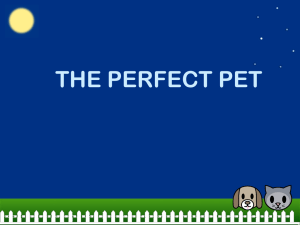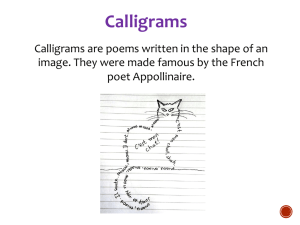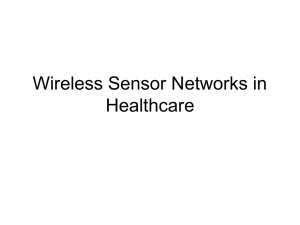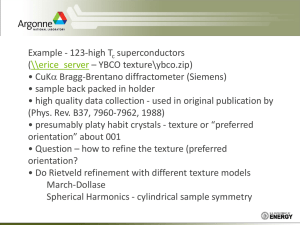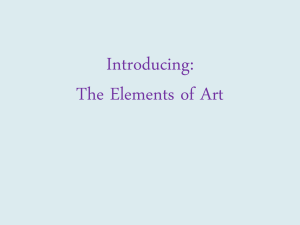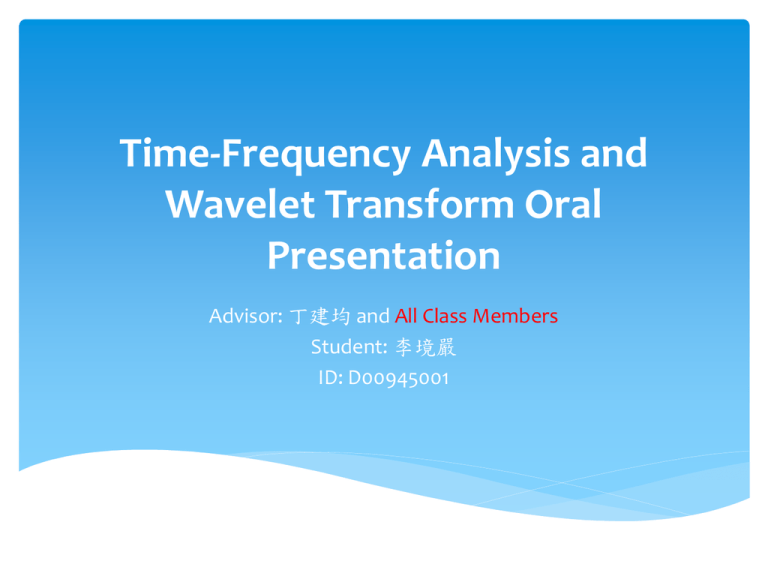
Time-Frequency Analysis and
Wavelet Transform Oral
Presentation
Advisor: 丁建均 and All Class Members
Student: 李境嚴
ID: D00945001
What’s Today?
XIII. Applications of Time–Frequency Analysis
(1) Finding Instantaneous Frequency
(11) Acoustics
(12) Biomedical Engineering
(2) Signal Decomposition
(3) Filter Design
(4) Sampling Theory
(5) Modulation and Multiplexing
(13) Spread Spectrum Analysis
(14) System Modeling
(15) Image Processing
(6) Electromagnetic Wave Propagation
(7) Optics
(8) Radar System Analysis
(9) Random Process Analysis
(16) Economic Data Analysis
(17) Signal Representation
(18) Data Compression
(19) Seismology
(10) Music Signal Analysis
(20) Geology
Wavelet Transform
Laws Texture
Kernel (Windows)
3
What’s Today?
Study of Classification of Lung Tumor Based on
CT/PET Images
Technique of studying image ( gray level)
Training skill of machine learning
Why Image Processing?
Gray level studying
DSP, Kernel( window)
Resolution of image
4000*3000, 1024*768, 640*480, 320*240
How about in Biomedical Image?
Why Image Processing?
The Biomedical Image Today
CT:
512*512
PET:
128*128
Why Image Processing?
Brain v.s. Lung Tumors
Outline
Introduction and Back ground
Technique
Experiments
Discussion and Conclusion
Introduction
Introduction and Back ground
Technique
Experiments
Discussion and Conclusion
Introduction
Lung Tumor
High Death Ratio
Nerve-less
Introduction
Image Load
Preprocessing
CoRegistration
Registration
Down / Up sampling ; Wavelet Transform
Classification
Feature
Feature
Extraction
Extraction
Wavelet ; Laws Texture ; Other Methods
ROI
Introduction--Wavelet Transform
Wavelet Transform:
J. J. Ding, 09月15日上課資料 , P 43
Introduction--Wavelet Transform
Ivan W. Selesnick, Wavelet Transforms, 2007
Introduction--Wavelet Transform
Introduction
y (2 n 1) c ( n ) d ( n )
Ivan W. Selesnick, Wavelet Transforms, 2007
y (2 n ) c ( n ) d ( n )
Introduction--Wavelet Transform
Ivan W. Selesnick, Wavelet Transforms, 2007
Ivan W. Selesnick, Wavelet Transforms, 2007
Introduction--Wavelet Transform
Introduction--Wavelet Transform
Wavelet Transform:
Improvement???
Haar !!
Introduction--Wavelet Transform
Haar Transform:
Introduction--Wavelet Transform
Wavelet Transform
Haar Transform
Introduction--Wavelet Transform
Wavelet Transform:
J. J. Ding, 09月15日上課資料 , P 46
Introduction--Wavelet Transform
Introduction—Laws Texture
Laws features
The texture energy measures developed by
Kenneth Ivan Laws at the University of Southern
California have been used for many diverse
applications. These measures are computed by first
applying small convolution kernels to a digital
image, and then performing a nonlinear windowing
operation.
http://www.ccs3.lanl.gov/~kelly/ZTRANSITION/notebook/laws.shtml
Introduction—Laws Texture
Laws features
3 element kernel
5 element kernel
High order kernel
M.T. Suzuki, Y. Yaginuma, H. Kodama, A Texture Energy Measurement Technique for 3D
Volumetric Data, 2009 IEEE International Conference on Systems
http://www.ccs3.lanl.gov/~kelly/ZTRANSITION/notebook/laws.shtml
Introduction—Laws Texture
Laws features
3 element kernel
Level: [1 2 1];
Edge: [-1 0 1];
Spot: [-1 2 -1];
M.T. Suzuki, Y. Yaginuma, H. Kodama, A Texture Energy Measurement Technique for 3D
Volumetric Data, 2009 IEEE International Conference on Systems
http://www.ccs3.lanl.gov/~kelly/ZTRANSITION/notebook/laws.shtml
Introduction—Laws Texture
Laws features
Introduction—Laws Texture
Laws features
5 element kernel
L5 = [1, 4, 6, 4, 1];
E5 = [−1,−2, 0, 2, 1];
S5 = [−1, 0, 2, 0,−1];
R5 = [1,−4, 6,−4, 1];
W5 = [−1, 2, 0,−2, 1];
% ripple
% wave
M.T. Suzuki, Y. Yaginuma, H. Kodama, A Texture Energy Measurement Technique for 3D
Volumetric Data, 2009 IEEE International Conference on Systems
http://www.ccs3.lanl.gov/~kelly/ZTRANSITION/notebook/laws.shtml
Introduction—Laws Texture
Laws features
Introduction—Laws Texture
Laws features
Image processing --- 2D case
L5L5
E5L5
S5L5
R5L5
W5L5
L5E5
E5E5
S5E5
R5E5
W5E5
L5S5
E5S5
S5S5
R5S5
W5S5
L5R5 L5W5
E5R5 E5W5
S5R5 S5W5
R5R5 R5W5
W5R5 W5W5
M.T. Suzuki, Y. Yaginuma, H. Kodama, A Texture Energy Measurement Technique for 3D
Volumetric Data, 2009 IEEE International Conference on Systems
http://www.ccs3.lanl.gov/~kelly/ZTRANSITION/notebook/laws.shtml
Introduction—Laws Texture
Laws features
Introduction—Laws Texture
L5L5
S5S5
W5W5
E5E5
R5R5
Introduction-- Background
CT - computed tomography
PET - Positron emission tomography
Introduction-- Background
CT - Computed Tomography
Digital geometry processing is used to
generate a three-dimensional image of the
inside of an object from a large series of
two-dimensional X-ray images taken
around a single axis of rotation .
http://translate.google.com/translate?hl=zh-TW&langpair=en|zhTW&u=http://en.wikipedia.org/wiki/X-ray_computed_tomography
Introduction-- Background
PET - Positron Emission Tomography
A nuclear medicine imaging technique that produces a three-dimensional image or
picture of functional processes in the body. The system detects pairs of gamma
rays emitted indirectly by a positron-emitting radionuclide (tracer), which is
introduced into the body on a biologically active molecule. Three-dimensional
images of tracer concentration within the body are then constructed by computer
analysis. In modern scanners, three dimensional imaging is often accomplished
with the aid of a CT X-ray scan performed on the patient during the same session,
in the same machine.
If the biologically active molecule chosen for PET is FDG, an analogue of glucose,
the concentrations of tracer imaged then give tissue metabolic activity, in terms of
regional glucose uptake. Although use of this tracer results in the most common
type of PET scan, other tracer molecules are used in PET to image the tissue
concentration of many other types of
http://en.wikipedia.org/wiki/Positron_Emission_Tomography
Introduction-- Background
PET - Positron emission tomography
FDG ( Fludeoxyglucose) :
氟代脱氧葡萄糖
http://en.wikipedia.org/wiki/Positron_Emission_Tomography
Background
CT
V.S.
PET
Technique
Introduction and Back ground
Technique
Experiments
Discussion and Conclusion
Technique
Feature Extracting – 1 (on CT)
Down sampling (for co-registry)
Overlap CT/PET( Down/Up Sampling)
Feature Extracting – 2 (on PET)
Machine Learning
Background
CT V.S. PET
Technique –
Feature Extracting – 1 (on CT)
Feature Extracting – 1 (on CT)
Volume
Rectangular Fit
Histogram features
Laws features
Wavelet
:
:
:
Technique –
Feature Extracting – 1 (Wavelet)
2D Case
Energy
1
MxN
Entropy
1
MxN
M
N
2
I (i, j )
i 1 j 1
M
N
i 1 j 1
2
I (i , j )
norm
2
2
log(
I (i , j )
norm
2
)
Technique –
Feature Extracting – 1 (Wavelet)
3D Case
Energy
1
MxNxL
Entropy
1
MxNxL
M
N
L
i 1
M
j 1 k 1
N
L
(
i 1
2
I (i, j , k )
j 1 k 1
2
I (i , j , k )
norm
2
2
) log(
I (i , j , k )
norm
2
)
Technique –
Feature Extracting – 1 (Laws Texture)
2D Case
Energy
1
MxN
M
N
i 1 j 1
2
I (i, j )
Technique –
Feature Extracting – 1 (Laws Texture)
3D Case
Energy
1
MxN
M
N
i 1 j 1
2
I (i, j )
Technique –
Down sampling (for co-registry)
Down sampling (for co-registry)
Raw Image
Low Pass
(Average)
High Pass 1
(X direction)
High Pass 2
(Y direction)
High Pass 3
(Corner)
Technique –
Down sampling (for co-registry)
Down sampling (for co-registry)
Raw Image
Low Pass
(Average)
High Pass 1
(X direction)
High Pass 2
(Y direction)
Down-samples Image
High Pass 3
(Corner)
Technique –
Feature Extracting – 2 (on PET)
Feature Extracting – 2 (on PET)
SUV
Leveled SUV
Largest Region’s SUV
Other probability features
Technique –
Feature Extracting – 2 (on PET)
Feature Extracting – 2 (on PET)
PAWITRA MASA-AH, SOMPHOB SOONGSATHITANON, A novel Standardized Uptake Value (SUV)
calculation of PET DICOM files using MATLAB, NEW ASPECTS OF APPLIED INFORMATICS, BIOMEDICAL
ELECTRONICS & COMMUNICATIONS
Technique –
Feature Extracting – 2 (on PET)
Feature Extracting – 2 (on PET)
Tumor
Level 1
Level 2
Level 3
Level 4
Level 5
Sub SUV
Sub SUV
Sub SUV
Sub SUV
Sub SUV
Feature
Feature
Feature
Feature
Feature
Technique –
Machine Learning
Machine Learning
Logistic
Neural Network
SVM (Support Vector Machine)
J48
Experiments
Introduction
Background
Technique
Experiments
Discussion and Conclusion
Experiments
Sorry, they are now in America
Discussion and Conclusion
Introduction
Background
Technique
Experiments
Discussion and Conclusion
Discussion and Conclusion
Discussion:
Relation between Image Processing, DSP,
and TWD
Kernel of Image Processing
Development of Each kernel
Discussion and Conclusion
Relation between Image Processing, DSP, and TWD
TWD:
Analyzing signal with mathematically way, either
enhancement of complexity of equation and reducing the
amount of computation.
DSP:
Dealing the signal with discrete time work.
DIP:
Take advantage of these two to give us more probabilities
on studying images.
Discussion and Conclusion
Kernel of Image Processing
Similar to the window function on short time signal
analysis
Either Gaussian filter (low pass filtering, averaging)
and edge detection (high pass filtering) are applied
to turn into features
Discussion and Conclusion
Development of Each kernel
Low pass filter
High pass filter
Discussion and Conclusion
Development of Each kernel
Low pass filter
Down sample ( average)
[1 1]
Laws texture (level)
[1 2 1], [1 4 6 4 1]
Gaussian blur (normal distribution)
[1 8 12 16 12 8 1]
Discussion and Conclusion
Development of Each kernel
High pass filter
Down sample ( change)
[1 -1]
Laws texture (edge, ripple)
[-1 -2 0 2 1], [1,−4, 6,−4, 1]
Gaussian Laplace Filter
Subtract by two Gaussian filter with same mean,
different STD.
Discussion and Conclusion
Development of Each kernel
High pass filter
Down sample ( change)
[1 -1]
Laws texture (edge, ripple)
[-1 -2 0 2 1], [1,−4, 6,−4, 1]
Gaussian Laplace Filter
Subtract by two Gaussian filter with same mean,
different STD.
Discussion and Conclusion
Development of Each kernel
High pass filter
Discussion and Conclusion
Development of Each kernel
High pass filter
Discussion and Conclusion
Conclusion:
Image processing is right an example which
implement DSP and TWD.
Texture Feature give doctors more clues for
diagnosing
More kinds of kernel provide more feature for
machine learning.



